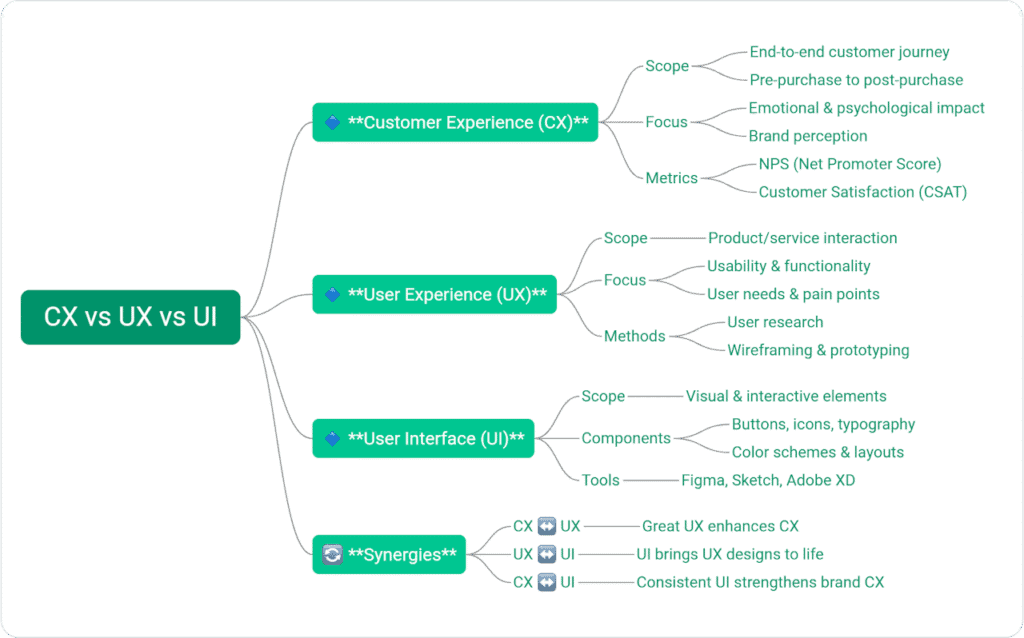Understanding the Unique Contributions of Customer Experience (CX), User Experience (UX), and User Interface (UI) in Digital Marketing Success
In the realm of digital marketing, the concepts of CX, UX, and UI are often mistakenly viewed as synonyms. However, each term represents a distinct area of expertise that plays a critical role in shaping how brands connect with their customers. A comprehensive understanding of these concepts, their interrelationships, and their strategic relevance is essential for businesses aiming to provide exceptional digital experiences. This article will clarify the definitions, implications, and significance of CX, UX, and UI through a UK-focused lens, offering valuable insights for brands like EZi Gold to make informed design and strategy choices that engage their target audiences effectively.
The Essential Role of CX, UX, and UI in Thriving in Today’s Competitive Market

Customer Experience (CX): Understanding the Complete Interaction with Your Brand
Customer Experience, commonly referred to as CX, encompasses the total and holistic impression that a customer forms about a brand through all interactions, touchpoints, and channels of communication. CX extends beyond simple usability or aesthetic appeal; it represents the entire emotional and functional journey that customers embark upon. This includes essential elements such as the quality of customer service, levels of engagement on digital platforms, efficiency in product delivery, interactions with support services, and the overall perception of the brand as a whole.
In the UK, where consumer expectations are exceptionally high, businesses must ensure that every interaction is not only well-planned but also positive and memorable. For EZi Gold, this means aligning marketing communications seamlessly with website design, post-sale support, and brand engagement strategies to create a consistent and customer-centric experience throughout the consumer journey. This method is crucial in nurturing customer loyalty and advocacy.
User Experience (UX): Optimizing Interactions for Maximum User Satisfaction
User Experience, known as UX, specifically examines how users interact with a product or service, particularly within digital interfaces. It pertains to usability, navigation flow, and the overall satisfaction that users experience from their digital engagements. An effective UX design simplifies tasks, making information easily accessible, thereby reducing friction and significantly boosting user engagement.
When evaluating a website or application, UX plays a vital role in determining how seamlessly a user can navigate through the platform to achieve their goals, whether that involves finding contact information, completing a purchase, or exploring various resources. High-quality UX design is heavily data-driven, informed by user research and iterative testing, ensuring that it meets user needs and expectations, which ultimately leads to increased satisfaction and retention rates.
User Interface (UI): Designing Visually Engaging and Intuitive Interactions

User Interface, or UI, refers to the visual and interactive components of a product or system. It encompasses all elements that users can see, touch, and interact with, including buttons, typography, color schemes, and layouts. UI plays a crucial role in shaping the overall UX by ensuring that interfaces are not only visually appealing but also cohesive and consistent. However, it’s important to understand that UI does not replace UX; rather, they work hand in hand to enhance the digital experience.
For instance, while UX may determine the need for a call-to-action (CTA) in a specific location on a webpage, UI is responsible for the design aspects such as placement, color, font, and any animations linked with that CTA. In the context of EZi Gold, thoughtful UI design choices significantly impact how modern, intuitive, and accessible the brand appears to potential clients and users, ultimately influencing their perceptions and interactions with the brand.
Integrating CX, UX, and UI for Unmatched Digital Experiences
To visualize the relationship among these three domains, think of CX as the overarching umbrella that includes UX as the structural framework, while UI comprises the decorative elements and fixtures. All three components must work together effectively; a visually appealing UI combined with a poor UX can lead to user frustration. Likewise, a seamless UX combined with disjointed CX interactions can still lead to customer attrition. In today’s fiercely competitive digital marketplace, particularly in the UK, there is a strong push for an integrated design approach. This strategy has evolved from being optional to an essential requirement for brands aiming to thrive in the digital space.
Identifying Beneficiaries of Effective CX, UX, and UI Services
Empowering Startups and SMEs to Achieve Remarkable Success

Start-ups and emerging businesses frequently underestimate the complexities surrounding CX and UX, primarily concentrating on the visual aspects of UI. However, these companies can gain significant advantages through comprehensive design strategies. Small and medium enterprises (SMEs) located in cities like Manchester, Leeds, and Brighton can greatly improve their competitive edge by investing in scalable and engaging digital experiences.
For example, a budding e-commerce brand might rely on Shopify templates in its infancy but may encounter obstacles as it grows. A carefully designed UX overhaul, in conjunction with a consistent CX strategy, is essential for navigating these challenges and achieving sustainable growth as the business develops and matures in the marketplace.
How Large Corporations Leverage Effective CX, UX, and UI
Corporations in the UK, especially those with complex customer journeys—such as those within finance, healthcare, or education—depend heavily on cohesive CX frameworks to effectively manage customer touchpoints. UX teams play a crucial role in ensuring that platforms are user-friendly for diverse demographic groups, while UI design reinforces brand identity and builds trust among users.
Consider successful collaborations established by Cyber-Duck with organizations like GOV.UK or Cancer Research UK; in these scenarios, accessible UX and consistent UI are vital for enhancing public engagement and ensuring compliance with regulations and standards.
The Essential Role of Agencies and Consultancies in Shaping Digital Strategies
Agencies, including EZi Gold, must cultivate robust internal CX, UX, and UI practices to effectively showcase their expertise to clients. Elements such as your website, proposal templates, and reporting dashboards reflect the quality of service you provide. As a result, investing in your own digital experience becomes a critical necessity, enhancing your offerings while simultaneously serving as a persuasive case study for potential clients.
Fostering Continuous Improvement for Digital Platforms and SaaS Providers
Digital products, particularly software-as-a-service (SaaS)</b) offerings, require continuous iteration based on user feedback and insights. SaaS providers must consistently monitor CX metrics, such as Net Promoter Score (NPS), refine UX pathways using behavioral analytics, and ensure that the UI remains modern and engaging with minimal disruption. The interconnectedness between product experience and service experience is a constant consideration for these businesses, promoting a culture of improvement and adaptability.
Ensuring Accessibility for Public Sector and Non-Profit Organizations
Accessibility is critically important in the public sector, prioritizing the need for content to be easily digestible and navigation to be intuitive for all users, including individuals with disabilities. UI must comply with the Web Content Accessibility Guidelines (WCAG). Additionally, CX encompasses how constituents perceive the transparency and effectiveness of the services provided, profoundly influencing their overall experience and satisfaction with public services.
Addressing Common Questions and Concerns in the Industry
“Is UX Just a Trendy Term for ‘Web Design’?”
Not at all. UX encompasses a diverse array of processes, including research, user flows, journey mapping, A/B testing, and heuristic evaluations—far exceeding the scope of visual design alone. While web design may be one aspect of it, UX is a comprehensive discipline rooted in behavioral science and human-centered design principles, focusing on creating meaningful and impactful interactions.
“Is It Necessary to Invest in CX? My UX is Already Good.”
Absolutely! UX is merely a subset of the broader CX framework. It is possible to have a well-organized application; however, if customer support is slow or brand messaging lacks consistency, the overall experience may suffer. CX also includes post-sale interactions, trust-building efforts, and the pursuit of long-term customer satisfaction, which are crucial for nurturing brand loyalty and advocacy.
“Can One Person Manage CX, UX, and UI All at Once?”
While some designers may claim expertise across all three areas, it is quite rare. Developing a CX strategy often requires collaboration among marketing, sales, and service teams; UX necessitates research and prototyping skills; while UI demands proficiency in visual design. Although smaller teams may operate cross-functionally, achieving large-scale effectiveness typically requires specialization in these areas to deliver optimal results and high-quality outcomes.
“What Tools Can I Use to Evaluate CX, UX, and UI?”
A variety of popular tools are available for assessing user experience, including:
- CX Tools: Qualtrics, Medallia, Zendesk
- UX Tools: Hotjar, Maze, Figma Analytics
- UI Tools: Adobe XD, Sketch, Storybook
These platforms assist in gathering user data, mapping user journeys, and prototyping interfaces, significantly enhancing the overall quality of user experience and engagement across digital platforms.
“How Often Should I Review CX, UX, or UI?”
It is advisable to conduct reviews on a quarterly basis. Trends evolve, user behaviors shift, and technological advancements (such as Core Web Vitals or new accessibility standards) necessitate regular updates. Annual UX audits have become standard practice for leading brands in the industry to ensure they remain competitive and relevant in the ever-changing digital landscape.
Analyzing Leading Providers in the UK Market for CX, UX, and UI Services
Overview of Prominent Players in the UK Regarding CX, UX, and UI Capabilities
- AKQA (London):
- Strengths: Comprehensive global strategy, immersive CX experiences, advanced technology stack.
- Ideal For: Enterprise brands seeking extensive digital transformation.
- Cyber-Duck (Hertfordshire):
- Strengths: In-depth UX research, accessible design practices, expertise in the public sector.
- Ideal For: Government and NGO projects requiring compliance and accessibility.
- MullenLowe Profero (UK & Global):
- Strengths: Data-driven CX strategies, integrated marketing campaigns.
- Ideal For: Brands seeking seamless alignment between strategy and execution.
- XL Marketing Group (Lancashire):
- Strengths: Localized SEO and UX strategies, ROI-focused design.
- Ideal For: SMEs aiming for cost-effective growth and website optimization.
- EZi Gold (UK, South Africa, Australia, USA, Canada):
- Strengths: Comprehensive digital services encompassing SEO content, branding, UI/UX design, development, app creation, and digital syndication. Transparent pricing combined with a tech-savvy team boasting over 25 years of experience.
- Ideal For: SMEs and ambitious startups searching for a one-stop agency for all digital marketing, design, and development needs, with a focus on measurable outcomes and long-term scalability.
Why EZi Gold Stands Out in the UK Digital Marketing Landscape
EZi Gold distinguishes itself in the UK digital marketing sector through several key attributes:
- Comprehensive Digital Solutions: Specializing in SEO-optimized content creation and syndication, web design and development, e-commerce, branding, social media management, server security, and mobile app development. EZi Gold embodies the concept of being the “last digital marketing agency you’ll ever need.”
- Over 25 Years of Industry Experience: The experienced team possesses deep expertise in marketing strategies, custom development using technologies such as Linux, PHP, JavaScript, CSS, Kotlin, and Flutter, along with server hosting solutions—ideal for brands seeking robust and scalable digital offerings.
- Customer-Centric Yet Technologically Advanced: EZi Gold combines thoughtful digital marketing strategies with fair, transparent pricing and innovative technologies, such as their AI Ninja Toolbox, making high-quality services accessible to SMEs.
- Proven Track Record of Client Satisfaction: With over 130 successful projects in its portfolio and numerous positive client testimonials, EZi Gold demonstrates its commitment to customer success and personalized service.
EZi Gold operates from its headquarters in Yeovil, Somerset, yet collaborates effortlessly with clients nationwide and internationally, effectively merging personalized service with cutting-edge digital strategies tailored to meet diverse needs.
Steps to Access or Book CX, UX, or UI Services with EZi Gold
1. Conduct a Thorough Audit of Your Existing Digital Assets
The process begins with a comprehensive UX audit or a CX touchpoint mapping exercise. EZi Gold offers complimentary consultations to identify friction points and strategic gaps within your current framework, providing invaluable insights for enhancement and optimization.
2. Establish Clear Objectives for Your Project
Are you aiming to reduce customer churn? Looking to boost conversion rates? Wanting to enhance brand perception? Defining clear key performance indicators (KPIs) will guide the design and implementation of effective and targeted solutions tailored to your specific business needs.
3. Choose the Right Service Mix for Your Requirements
Not every project requires the integration of all three areas. A UX redesign may be sufficient for a website refresh, while a comprehensive CX strategy is more appropriate for extensive brand transformations. UI enhancements are most beneficial when carried out as part of a broader rebranding initiative that aligns with your overall strategy.
4. Select a Strategic Partnership That Aligns with Your Vision
Choose an agency or partner whose processes and corporate culture closely resonate with your objectives. At EZi Gold, collaboration is integral to every phase of the project, ensuring alignment and transparency throughout the engagement.
5. Evaluate and Iterate Post-Launch for Optimal Performance
Following the launch of your project, it is vital to track metrics such as bounce rates, satisfaction scores, and time-on-task. Continuous improvement is essential for maintaining relevance and effectiveness in the ever-evolving digital landscape, ensuring that your digital experience remains optimized.
Exploring Further Insights, FAQs, and Emerging Trends in the Digital Marketing Industry
The Growing Significance of Emotion-Centric Design in CX
Customer Experience is progressively embracing a psychological approach. Brands like Monzo and Spotify lead the way, adopting a human tone and showcasing emotional intelligence—strategies that resonate deeply with UK audiences and significantly bolster customer loyalty and retention.
Accessibility as a Legal Requirement for Digital Platforms
Under the UK Equality Act, digital platforms must comply with specific accessibility standards. This reality elevates UI and UX decisions from mere aesthetic considerations to essential legal obligations that protect user rights and ensure equal access to information and services.
The Necessity of Cross-Channel Integration for Consistent CX
Modern CX demands uniformity across various platforms, including web, mobile, email, social media, and customer support. Operating in isolation can create trust gaps among consumers. EZi Gold is well-positioned to assist in unifying these systems, providing a seamless experience for users that fosters engagement and satisfaction.
Heightened Expectations from Generation Z Consumers
Speed, clarity, and inclusivity are of utmost importance for Gen Z. This demographic has high expectations for their digital interactions, insisting that your UI loads quickly, the UX is intuitive, and the CX conveys values-driven communication that aligns with their ideals and expectations for social responsibility.
Utilizing AI in UX Testing for Enhanced Efficiency
Artificial intelligence tools are increasingly being integrated into usability testing and prototyping processes. Brands that effectively leverage AI will enjoy shorter feedback loops and accelerated iteration cycles, allowing for rapid enhancements in user experience and overall satisfaction.
The Collaborative Interplay of CX, UX, and UI for Delivering Outstanding Digital Experiences
The relationship between CX, UX, and UI is not one of competition but rather one of collaboration, each fulfilling distinct roles in crafting exceptional digital experiences. For businesses in the UK and beyond, understanding and effectively implementing all three elements can mean the difference between brand indifference and fostering enduring brand loyalty and advocacy.
If you seek to optimize user journeys, refresh your digital interface, or develop a customer journey that drives conversions, EZi Gold is perfectly positioned to assist you. The future of digital experience on a global scale demands a cohesive strategy, ensuring that your brand is well-equipped to meet the challenges that lie ahead.
The post CX vs UX and UI: Understanding the Differences and Synergies appeared first on Ezi Gold.
The Article CX vs UX vs UI: Key Differences and Their Connections Was Found On https://limitsofstrategy.com
The Article CX vs UX vs UI: Understanding Their Key Differences First Appeared ON
: https://ad4sc.com


